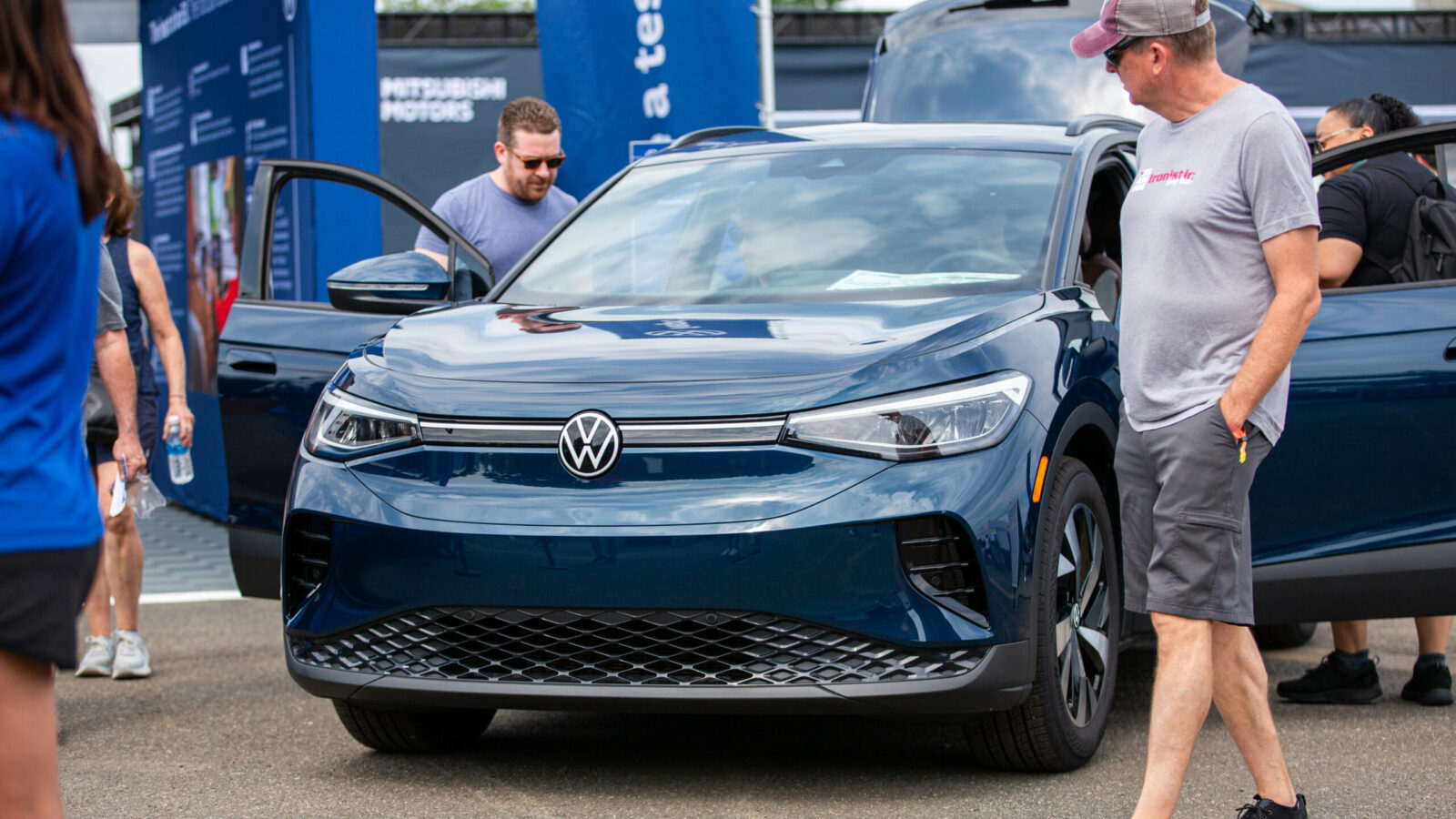- The US power grid can support charging 80 million EVs during overnight hours.
- Only 16.5 million EVs are on the road around the world.
- EV drivers average 39 miles per day, so they only need to charge once every six days.
- The US government will add off-grid EV charging stations to 140 offices around the US.
- The US grid gets over 50% of its energy from renewable sources.
With baseball-and-apple-pie automakers like Chevrolet and Dodge set to release new electric vehicles in 2024, eyes are turning to charging infrastructure. Can the power grid support an influx of new electric vehicles?
Unfortunately, misinformation has deemed the power grid incapable of charging EVs, and plenty of myths abound about how EV charging causes more harm to the environment than exhaust from ICE vehicles. In reality, the electric grid can handle EVs even with the influx of new models arriving on dealership lots.
Other myths create falsehoods about EV prices, lack of infrastructure, and the inability to travel outside of your city. These myths plague the EV industry and keep potential buyers away from the eco-friendly, money-saving, and exciting mode of transportation. Knowing the facts help drivers make better decisions about driving and charging electric vehicles.
Myth 1: The electric charging grid cannot support the upcoming lineups of new electric vehicles.
This myth couldn’t be farther from the truth. In the United States, the electric grid has plenty of space to support battery electric vehicles (BEVs) like those from Tesla, Mercedes-Benz, and Kia.
A Mosaic of Powertrains
The myth exists because people think that BEVs will be the only vehicles on the roads, and this is far from the truth. Vehicles with internal combustion engines and alternative power sources – like hydrogen, will share the roads with lithium-ion-powered cars.
Gone are the days when one energy source – like petroleum – powers our vehicles. Instead, we can expect to see a mosaic of powertrains making the myth of “an EV in every garage” very unlikely. The variety of power sources will prevent a mythological grid overload.
Off-Peak Charging Incentives
Currently, the best time to charge electric vehicles is during off-peak times. Charging overnight costs less, and the grid has less demand from other industries. Utility companies offer incentives to EV drivers to charge overnight. For example, EV drivers in Michigan can get a $10 monthly rebate on their electric bills if they charge at home during overnight hours. As more utility companies turn to renewable energy from solar and wind, charging stations will become more efficient during daylight hours.
Returning Power to the Grid
With two-way charging, EVs can help power the grid. Vehicles like the Ford F-150 Lightning and the Hyundai Ioniq 5 can charge generators. In the future, they can be used to help supply energy grids when demand is high after they charge when demand is low.
Can the Electric Grid Handle EVs in California?
Those who perpetuate myths about electric vehicles and the power grid often make up stories about California and misinformation about overloaded grids. In reality, the state leads the way with EV sales, and charging them is barely creating a dent in the state’s power grid. More than 1 million electric vehicles are registered in California, and charging them uses less than 1% of the state’s grid, even while charging during the day.

Doing the Math
On a typical hot August day, the US electric grid can charge up to 80 million electric vehicles during nighttime hours between 11 PM and 6 AM. When air conditioning units are ramped up between 2 PM and 8 PM, the grid could become overloaded so charging EVs could create issues. With only 16.5 million EVs around the world, it’s safe to say that EV impact on the power grid will be low.
Most electric grids were developed before the advent of EVs, but they can be managed with demand-management systems and coordinated, dynamic charging times. Fortunately, most drivers don’t need to charge their EVs nightly, so the grid has not been pushed to its capacity. According to AAA, EV drivers average 39 miles per day. If that EV has a range of 250 miles, the average EV driver needs to charge once every six days.
Myth 2: Charging electric vehicles creates as much carbon dioxide as the exhaust from vehicles from internal combustion engines.
This myth involves misinformation about how utility companies power their grids. While some communities still rely on fossil fuels like coal, as a whole, the United States power grid gets less than 50% of its energy from coal. Instead, utility companies power communities using solar, wind, nuclear energy, and natural gas.
Increasing Reliance on Clean Energy
According to the U.S. Energy Information Administration, in 2021, coal accounts for 22% of energy use, while petroleum accounts for only 1%. Those numbers will continue to drop as more communities rely on renewables and other clean energy sources.

Charging your EV creates upstream emissions while driving an ICE vehicle creates tailpipe emissions. You can investigate your vehicle’s impact on the environment using the Department of Energy’s Beyond Tailpipe Emissions Calculator. Find your vehicle and enter your zip code to see how your EV or Plug-in Hybrid EV stacks up against the typical ICE vehicle.
Investing in Off-Grid Solar EV Charging Stations
Several companies are producing parking lot charging stations powered by solar canopies. These off-grid charging stations are putting an end to the myth of dirty charging. As the technology becomes less expensive, businesses striving for LEED certification and other eco-friendly designations will add off-grid solar ev chargers for their customers and employees. The federal government has contracts to add 140 off-grid solar charging stations to 34 Department of Veterans Affairs offices around the country.
Myth 3: Charging infrastructure does not support interstate road trips.
While some rural communities lack EV charging stations, the current infrastructure does support drivers who want to embark on long road trips. Range anxiety can be an issue in some areas of the country, so using an app like Chargeway can ease the stress by planning your route around the nearest charging stations.
Charging Stations in Rural Areas
As more drivers turn to electric vehicles, more companies are installing charging stations – especially DC Fast Charging stations along highways. For example, the Midwest grocery chain Meijer is working with Tesla and Electrify America to add EV charging stations in key locations, especially in rural areas.
Charging Ports and Gas Stations: By the Numbers
KPMG reports that the United States has 31,753 public EV charging facilities, with 4,325 being DC Fast Charging Stations with 17,409 outlets – all without crashing the power grid. Comparing these numbers to the 168,000 gas stations with eight or more pumps, it’s easy to see where the myths about road trips and range anxiety exist.
The federal government has allocated $7.5 billion to add EV infrastructure, and soon the EV grid of charging ports will outnumber gas stations. Every day, EV drivers cross state lines and take long road trips without worry, especially with Tesla opening its massive fast-charging network to non-Tesla EVs.
Can the US Energy Grid Support EVs? YES!
So, the answer to “Can the power grid handle electric cars?” is a resounding yes. The US power grid will not have to support 100% of the cars on the road thanks to a future of vehicles powered by electricity, petroleum, hydrogen, and more.

FTC: We use income-earning auto affiliate links. Learn more.












5 Responses
I noticed that you have not mentioned the cost of batteries or where to dispose of the used batteries or how large trucks that carry our goods and food will be able to traverse thousands of miles or how will railroads operate or the average cost of a ev I could go on but I will stop.
Since batteries last an average of 300,000 miles, the cost of replacing them isn’t an issue. Less than 1% of EVs on the road have had their battery replaced. Batteries that degrade to below 70% usable capacity after 300,000 miles are normally re-purposed as backup storage for solar panel arrays. Defective or damaged batteries are recycled, as 94% of the material used to manufacture the battery can be recovered and re-used to manufacture new EV batteries. Large trucks will likely rely on Hydrogen fuel cells for long distance travel. The Hydrogen fuel cell provides the electricity to power the truck.’s electric motor. Currently Govt funds are in place for a network of Hydrogen fueling points along major long-haul trucking routs. You do know that trains are all electric now, right? That big engine pulling the train is mostly a giant electric generator that powers electric motors in the train’s wheels.. Currently the generator runs on diesel fuel, but conversions to hydrogen is in the future.
Most of what’s in this article is BS. 50% of our grid energy is from renewables??!! LOL!! try 12%.